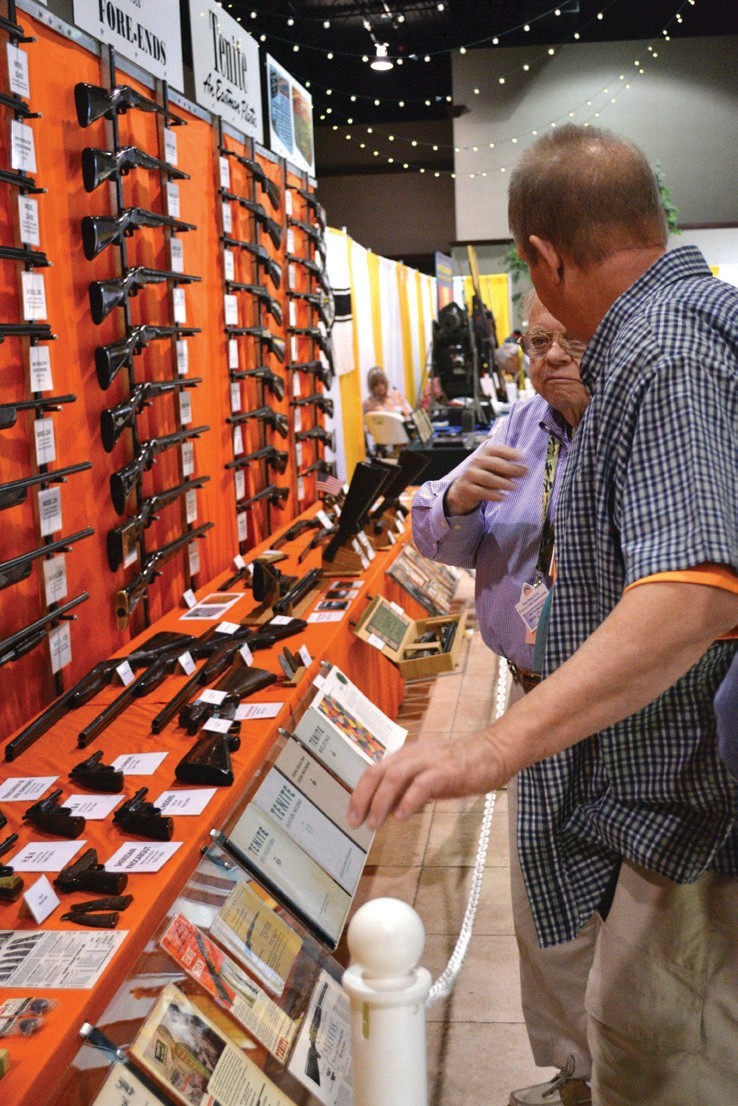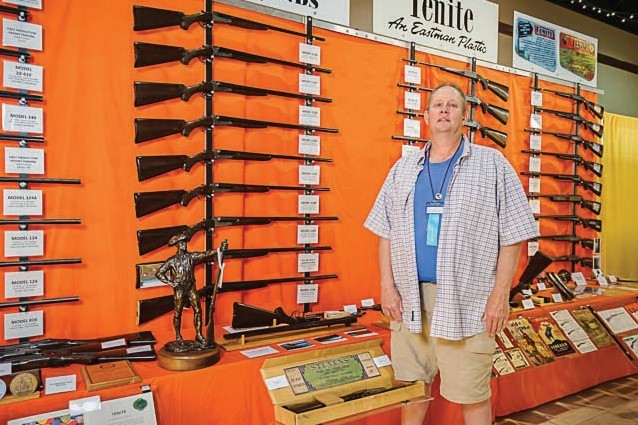Most gun show walkers at one time or an- other have come across an old Stevens model with a plastic stock and forend. The wood grain looking material has fooled many with its glossy look. Some buy these pieces of history and add them to their collection, and many remember them as their first gun or one once owned by their father or grandfather.
I was inspired by my stepfather’s Stevens S/S 16 ga. which I used for my first pheas- ant harvest at age 12. After that, collecting was in my thoughts as I searched shows. Not having a lot of money to work with, these unique firearms caught my eye. Be- ing priced lower than the wood stocked variations, the collection began. Twenty- years ago, no one really wanted them so the prices were right.
The May 2016 OGCA Display Show is where my display “TENITE STOCKS and FORENDS” appeared in Ohio. Many people said, “I didn’t know there were so many.” Neither did I, having nothing but old ads and catalogs for information. My search continues finding different varia- tions of models all the time.
Most Steven models were produced with Tenite, including models, 15, 87, 22/410,240, 124, 820, 94, and the 5100 which is the only one in which the receiver was modified to accommodate the Tenite stock. I believe this was done for support. The only long gun produced that was not Stevens is a Noble model 33 pump 22. Many handguns carried the Tenite grips as well, including H&R, Iver Johnson’s, JC Higgins, and Sheridan.

Joel Van Zante explaining his unique, educational tenite stock exhibit.
The earliest advertisement I have found is from 1938 for Stevens’ 530 M 16 ga S/S. This, I believe, is the first stocked synthetic shotgun, and it has yet to be added to my pile because I haven’t found one yet. I’ve only heard stories of its’ existence. The most common is the 22/410 which is the easiest gun to find stocked with this unusual material.
Many versions of these models exist, each with their own built to order variations. JC Higgins S/S’s have a beaver tail forend. Shapleigh’s with the white butt plate, grip cap, and front white square sight are a rarity. Most of the white butt plate’s have deteriorated over the years. Many that I have found are worn down or just gone. These stocks were made in the late 1930s and 1940s and sold into the 1950s.
Tenite starts out as a softwood tree which is converted to wood pulp, and a cellulosics plastic compound is added. The stock and grips are injection molded which creates the swirling wood grain look. A variety of colors were made from white to black.
Many other products were made from Tenite; telephones, radios, car parts, and fishing lures to name a few. Eastman plastics ran ads promoting the use of its products during the war. Tenite was used as a replacement for valuable metals to aid in the war effort. Bugles and uniform medallions were produced. Bayonet scabbards were coated to add strength. Some bullets had Tenite injected in the tip to help with flight. An unusual find was a soldier’s snake bite kit. The suction tool was Tenite, as were Jeep steering wheels of course.
In the ads, words like “unbreakable” and “indestructible” were used to sell this new and versatile material. However, Tenite does have a few flaws. Cold and heat are not friendly to these guns. It is brittle in low temps, and with long exposure to excessive heat it will revert back to a saw dust. The most common issue is the white mold which can grow on this organic product, but it is easily cleaned up with window cleaner and a tooth brush. Heavy growth requires soaking to soften, and I use a wood shim for scraping without scratching the surface. In addition some ask, “What is that smell?” Old catfish bait comes up occasionally, but most agree dirty diapers wins the vote.
Most guns in my display are quite worn from years of use in the field. These models were the working man’s gun. But with some time, most scratches can be polished out. The stocks are colored all the way through so even deep scratches can be sanded out, buffed and polished to look new again. A high speed bench polisher creates too much heat and can melt the surface. I use an 18 volt cordless drill, cloth polishing wheel and Novus #2 polish. Be careful not to buff out the checkering on the grips and forends.
Colors vary from time periods and batch mixes. It is not uncommon to find a gun where the stock or forend has been switched and don’t match.When storing your Tenite guns remember gravity is constant so setting the gun with the barrel up over a long time can cause the stock to bow. Barrel down would be better, but mine are stored trigger guard up with support at stock and barrel. Attic storage is not a good idea due to excessive heat.
The large plug in the butt plate is for removing the stocks. I heard stories of stocks being filled with sand for weight, but most have wood filler inside. So, if you pick one up and hear a loose part, that is most likely the wood filler, a com- mon issue with the 87 rifle. Cracks can be repaired with a hobby model glue. Missing pieces can be filled with JB Weld but the color will never match. Stocks and forends are out there but are becoming harder to find unbroken. So, check your “miscellaneous” boxes at shows and auctions as you will never know what you may find.
Displaying my collection is most rewarding for me when a gentleman looking over my display points and says, “That’s the first gun I ever owned.” It brings back those memories for him, and puts a smile on my face. Then of course, he will tell the stories that go with it, and that is invaluable. Twenty some years of searching for Tenite stocked guns have inspired me to put what I have found in a book, and I’m working on. Feel free to contact me for information, or perhaps to describe an unusual Tenite stocked gun for my book at jvanzante@southslope.net
Members like Joel are an inspiration to the next generation by proving that an exceptional collection can be acquired over time without breaking the bank. In addition, Joel’s incredible exhibit at the May 2016 Annual Display Show received the Robert Rubendunst Best Educational Display award. Many thanks to this new member from Iowa for an outstanding display and informative article.

Joel Van Zante with his Minuteman Freedom Bronze, for Best Educational Award on Tenite stocks.

Tenite Stocks and Fore-Ends display at the 2016 OGCA Annual Display Show


